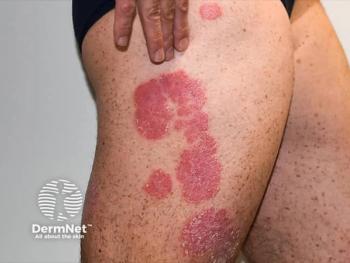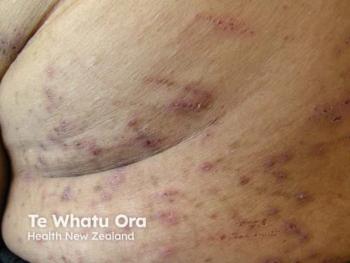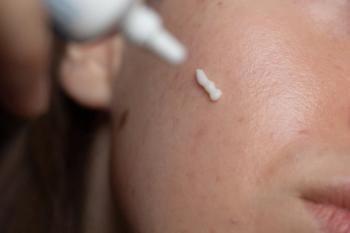
- Dermatology Times, May 2025 (Vol. 46. No. 05)
- Volume 46
- Issue 05
Real-World Management Strategies for Alopecia Areata
Key Takeaways
- Alopecia areata affects a small percentage of adults and children, often with comorbid conditions, and presents in various forms mimicking other disorders.
- The Severity of Alopecia Tool (SALT) score is essential for assessing hair loss severity and guiding treatment decisions based on patient-specific factors.
Explore innovative strategies for managing alopecia areata with insights from expert Susan Taylor, MD, FAAD, highlighting breakthrough JAK inhibitors and real-world case studies.
In a recent Dermatology Times Case-Based Peer Perspectives custom video series,
Alopecia areata affects approximately 0.18% of adults and 0.1% of children. It occurs more frequently in women and certain ethnic groups. Patients with alopecia areata often have comorbid conditions like diabetes, rheumatoid arthritis, atopic dermatitis, and thyroid disorders. The disease is known for its patchy hair loss pattern but can present in various forms and patterns that may mimic other hair loss disorders like androgenetic alopecia or syphilitic alopecia.
Assessing Severity and Tailoring Treatment
Taylor stresses the importance of using the Severity of Alopecia Tool (SALT) score to determine the severity of hair loss and guide treatment decisions. The treatment approach is also influenced by factors like patient age, disease duration, comorbid conditions, and the patient’s personal preferences. Additionally, patient expectations play a significant role in treatment planning. For instance, some patients may be more concerned about regrowing eyebrows and eyelashes than about scalp hair, which can influence the therapeutic strategy. For pediatric and adolescent patients with severe alopecia areata, FDA-approved Janus kinase (JAK) inhibitors like ritlecitinib (Litfulo; Pfizer) and baricitinib (Olumiant; Lilly/Incyte) are considered effective treatment options.
Therapy Breakthroughs With JAK Inhibitors
For pediatric and adolescent patients with severe alopecia areata, ritlecitinib and baricitinib have been game changers. These oral medications target the JAK/STAT signaling pathway, which plays a crucial role in the immune system’s attack on hair follicles. IFN-γ and IL-15 are key molecules involved in the pathogenesis of alopecia areata, and JAK inhibitors can help block this process.
“We live in quite a remarkable time in 2025 because we have these FDA-approved agents for alopecia areata,” Taylor said. “Prior to their approval, our therapeutic armamentarium was quite limited.”
Previous treatment methods often focused on corticosteroids, immunotherapy, or minoxidil. Taylor highlights that ritlecitinib and baricitinib offer a promising solution, significantly improving hair regrowth in adolescent and adult patients. However, as with any new treatment, the long-term effectiveness and safety profile are important considerations.
Case 1: Severe Alopecia Areata in an Adolescent Boy Aged 16 Years
The first case described an Asian adolescent boy aged 16 years with severe alopecia areata, evidenced by a SALT score of 70 and partial loss of his eyebrows. He reported that his hair loss began several months ago and has progressively worsened. His mother noted that he had become socially withdrawn due to the impact of his hair loss.
Taylor focused on the patient’s SALT score, the presence of nail pitting, and his history of mild atopic dermatitis. The patient’s ethnicity also raised the possibility of a higher prevalence of alopecia areata. Given the severity of his condition and his age, Taylor recommended initiating treatment with ritlecitinib, as it is approved for adolescents 12 years and older.
Case 2: Chronic Alopecia Areata in a Woman Aged 32 Years
The second case involved a White woman aged 32 with a 3-year history of alopecia areata. She presented with sparse hair loss and total loss of her eyelashes and eyebrows, resulting in a SALT score of 85. Although the patient had previously used intralesional corticosteroids for her scalp, she was averse to needles. She was seeking alternative treatments for her condition, particularly for regrowing her eyebrows and eyelashes.
Given her age and the severity of her alopecia, Taylor recommended baricitinib, a JAK inhibitor approved for patients 18 years and older. With a SALT score of 85 and complete loss of her eyelashes and eyebrows, baricitinib at a 4-mg daily dose was chosen as the most appropriate treatment. Taylor also discussed topical treatments, such as corticosteroids or bimatoprost for eyelashes, to complement systemic therapy.
In both cases, Taylor emphasized the importance of managing patient expectations and discussing the potential risks, including the possibility of serious infections or cardiovascular events associated with JAK inhibitors. Long-term adherence to treatment was highlighted as critical for optimal outcomes. Nonetheless, these revolutionary therapies provide a more effective and less invasive treatment option for adolescents and adults. However, challenges remain in achieving even better results and understanding the long-term sustainability of hair regrowth after treatment cessation.
Alopecia areata significantly affects patients’ quality of life. Addressing the physical and emotional aspects of the disease is crucial. With the advent of JAK inhibitors, dermatologists now have a powerful tool to offer patients who are struggling with this challenging and often emotionally distressing condition. However, ongoing research and combination therapies may further enhance treatment outcomes and provide hope for even better results in the future.
Articles in this issue
Newsletter
Like what you’re reading? Subscribe to Dermatology Times for weekly updates on therapies, innovations, and real-world practice tips.


















